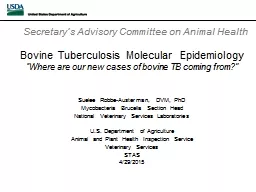

Where are our new cases of bovine TB coming from Suelee RobbeAusterman DVM PhD Mycobacteria Brucella Section Head National Veterinary Services Laboratories US Department of Agriculture ID: 913014
Download Presentation The PPT/PDF document "Bovine Tuberculosis Molecular Epidemiolo..." is the property of its rightful owner. Permission is granted to download and print the materials on this web site for personal, non-commercial use only, and to display it on your personal computer provided you do not modify the materials and that you retain all copyright notices contained in the materials. By downloading content from our website, you accept the terms of this agreement.
Slide1
Bovine Tuberculosis Molecular Epidemiology“Where are our new cases of bovine TB coming from?”Suelee Robbe-Austerman, DVM, PhDMycobacteria Brucella Section HeadNational Veterinary Services LaboratoriesU.S. Department of AgricultureAnimal and Plant Health Inspection ServiceVeterinary ServicesSTAS4/29/2015
Secretary’s Advisory
Committee on Animal
Health
Slide2ObjectivesHistorical perspective of State-Federal Cooperative Bovine Tuberculosis Eradication Program Describe whole genome sequencing (WGS) and how USDA is using WGS to inform traces and support epidemiology.Describe the WGS characteristics of the last 132 (18 yrs. span) new US affected herds.Discuss the importance of a quality database.2
Slide33Percentage of U.S. Cattle Responding to the Skin Test, 1917 - 2014PercentageOf Cattle RespondingTB testing begins nationwide
4.9%
U.S. declared Modified Accredited Free
0.46%
~
1% today (expected fraction of false positives)
Slide4Affected Cattle and Cervid Herds, FY 1987-20144
Slide5TB Cases Identified Per 100,000 Cattle Imported and Number of Cattle Imported from Mexico, 1998–201411Includes Mexican origin cases with and without official identification beginning in FY 2008. Import data not available prior to 2003.5
Slide6Genotyping using WGS2011 – First bench-top Next-Gen sequencer. 2011 – NVSL started a WGS pilot for TB and Brucella.December 2012, WGS replaced traditional lower resolution methods.
Slide7Impact of WGS was immediateHeiferette, no identification slaughtered in AZ, Sept 2012Traced to cattle dealer in CAAn assembled lot of 172 animals from 78 herdsNVSL-ARS evaluated animal geneticsHolstein, likely bull bredTraditional bacterial genotypingMatched several Mex isolates and a 2002 herd from CA, only 1 locus different from 100’s of isolates.This information was not enough to alter testing priorities in the field.
Slide8WGS – changed the field responseTimeMexican Dairy Isolates
Mexican Dairy Isolates
2002 CA Dairy herd
2012
Heiferette
Slide9WGS – changed the field responseCA repriorized the their investigation and found the new herd.Reduced the time to detection.Reduced testing of “innocent bystander” herds.
Slide10WGS can reassure trading partnersIn 2013 a dairy herd in MI was detected outside the MAZ. The WGS results support the epidemiological investigation suggesting the introduction likely occurred when cows were purchased from the Northeastern lower peninsula in the late 1990’s prior to movement controls.
Slide11Complications- detection of a steer 1yr. later
Slide12Saginaw dairy isolatesHolstein steer
SNPs developed within the Saginaw dairy
Slide13Where are USA bTB cases coming from?Low level circulation or residual infection occurring within the USA herd?New introductions?132 affected herds
Slide14Database of sequenced isolates127/132 (96.2%) affected USA cattle / cervid herds sequenced since 1998342/385 (88.9%) fed cattle (import and domestic) since 2000306 Mexico origin 68 unknown 9 USA origin 2 Canada origin ~175 Mexican cattle - mostly dairy 77 Human
Slide15Affected US cattle / cervid herds35 Strain types have been identifiedThree strain types accounting for 75/130 (58%) of herds have been documented in the USA for at least 25 years. (MI and Cervid A, B)32 strain types unexplained Unknown residual infections?New introductions?
Slide16Where are USA bTB cases coming from?Strain TypesOriginNo. USA herdsComment3USA75 (57%)MI, Cervid A, Cervid B9Unknown9 (7%)Avg
distance to MRCA = 3223Mexico
48 (36%)Includes MN, CO, CA
Slide17CHICHI
CHI
CHI
TAM
TAM
DUN
COA
COA
UNK
2012 SD Affected herd
ZAC
Slide18Where are USA bTB cases coming from?Strain TypesOriginNo. USA herdsComment3USA75 (57%)MI, Cervid A, Cervid B9Unknown9 (7%)Avg
distance to MRCA = 3223Mexico
48 (36%)Includes MN, CO, CA
Slide1923 Strain types (36%) anchor to MexicoHow are they coming to the US?Imported cattle? Expect to find some closely related isolates from imported Mexican feeder cattle.
Slide20Imported cattle – 1 herdNo links to imported cattle for 22/23 strains that anchor back to Mexico.Could we be missing the cases in our slaughter surveillance program?Is there another potential source?
Slide21Washington caseAdult dairy cow from Washington.Investigated the herd- purchased as a heifer no other infection identified.Neighbor was a rodeo contractor.
Slide22With Mexico collaboration:The most closely related isolates to the Washington dairy cow are 2 human isolates from Baja CA, and Baja CA dairy cattle isolates anchor this strain to Northern Baja CA
Slide23Two South Dakota untraceable cows
Slide24The dairy cows matching the SD beef cows were identified due to a collaboration with Mexico and were from the State of Mexico (Greater Mexico City).Dairy cattle, and cattle originating from the red areas are banned from importation to the US.
Slide25Additional collaborations with Public Health….
Slide262009 CA Dairy
Slide272013 CA Dairy and Beef herds
Slide28Assisting Public HealthHuman isolates = RedCattle isolates = Blue
Most human isolates are from Southern CA.
Most cattle isolates were from an abattoir in Tijuana.
CDC notified CA of a cluster of isolates with the same genotype for investigation. Requested WGS assistance from USDA.
Slide29SummaryWGS allows us to trace new cases more effectively. Over half (57%) of the USA affected herds can be traced to 3 strains documented to be in the USA in the early 1990’s.36% of US herds can be linked to Mexico. None of these cases can be linked back to Mexican fed cattle. 1 case was linked to a roping steer.A surprising number of US affected herds share a most recent common ancestor with Mexican dairy cattle or human isolates.
Slide30SummaryThe database of sequenced isolates is still small and limited in scope. It is critical to work with Mexico to improve the resolution of the database to assist both countries.These results may facilitate cooperation between animal and public health officials.